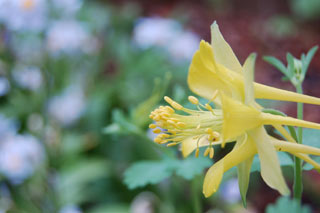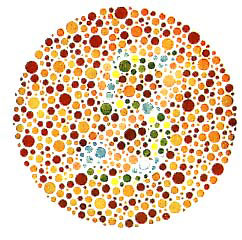Human Flower Project
Friday, March 30, 2007
Color Blind? Go for the Yellow
Take a color blindness test and help us strike gold.
 Crocus in McHenry Co., IL
Crocus in McHenry Co., IL
Photo: Cal Skinner
At last, across much of the U.S., the forsythia is blooming and daffodils are opening. Good news for all, especially the color-challenged.
Illinois blogger Cal Skinner turned on the lights for us with his photo of early golden crocus in bloom and a recent post (3/28):
Message of the Day – A Color
And the color is yellow.
That’s the color of my flowers of choice.
The reason is simple.
I have a hard time seeing pastels.
Even red gives me a problem.
That’s probably because I am red-green colorblind.
Hint: be wary of me at any intersection where the traffic lights are not vertical.
In any event, I like yellow flowers because I can see them vividly.
If the other colors are as vivid to other people as yellow is to me, we live in a beautiful world.
Thanks for this bit of consciousness-raising, Cal.
 Texas Gold columbine (with iris)
Texas Gold columbine (with iris)
March 25, 2007
Photo: Human Flower Project
May we recommend to you some of our own favorite yellows that should do well there in Northern Illinois?: celandine poppy, coreopsis, and (the gold standard) sunflowers. Right now in Central Texas, primrose jessamine is giving way to two other yellows: Lady Banks rose, and Texas columbine. (We’re not sure whether Texas Gold and Hinckley’s columbine are one and the same or not, but both are yellow rocket ships, soaring now through April.)
In Vietnam yellow flowers, especially bong mai and chrysanthemum, are beloved, their color signifying both happiness and prosperity. On the contrary, in parts of the Near East, yellow flowers are avoided, as they suggest sickliness and death.
 What number do you see?
What number do you see?
Image: Toledo Bend
Have you ever wondered about your own color receptivity? According to one source, color blindness affects “12 – 20 percent… of the white, male population and a tiny fraction of the female population.” Take this online test if you like, or several more tests. Or, for a quickie diagnosis, take a look at the circle at left. What number (if any) do you see inside? Check your results right here.
Thanks again, Cal, for waking us up to this very quiet deficiency, one that, to be sure, has a big impact on the human-flower relationship. It may explain in part why women seem generally to be more sensitive to flowers than men.
And readers, for Cal and the rest of us yellow flower fanciers, please tell us about your favorite golden blooms.




